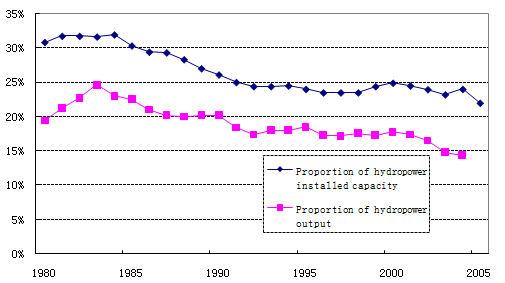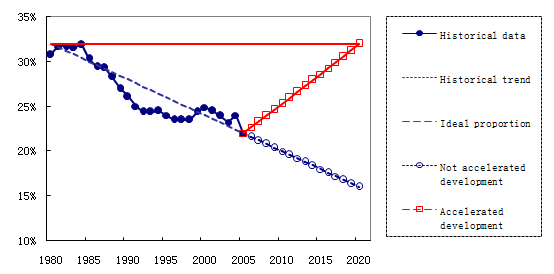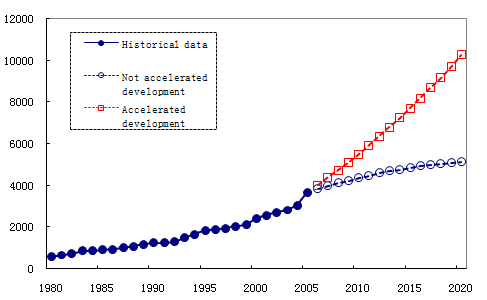Accelerating Hydropower Development Is Significant to Economic and Social Development of China
Dec 13,2006
By Lai Youwei & Wang Jinzhao
China has abundant hydropower resources, but its development is still at a low level. Hydropower is a clean, renewable, convenient for peak-shaving and high-quality energy with double functions of primary and secondary energy sources. The advantages of hydropower development are much more than disadvantages, and accelerating hydropower development is significant to economic and social development of China. We should enhance the awareness of hydropower development from the strategic viewpoint of implementing scientific outlook on development and building a well-off society in an all-round way, foster an idea of giving priority to hydropower development and take effective measures to support hydropower development.
I. Hydropower Development Is Beneficial for Full Utilization of Waterpower Resource to Ensure Low-cost and Reliable Energy Supply in China
China ranks the first in terms of waterpower reserve and technically developable hydropower resources around the world. Although China’s installed hydropower capacity has been increased rapidly in recent years and the output has exceeded 100 million KW in 2004 (excluding that of Chinese Taiwan Province), hydropower development is still at a low level and great disparity remains among different regions. By the end of 2004, China’s installed capacity of hydropower (108.26 million KW) accounts for only 20.0% of technically developable hydropower resources (541.64 million KW), and 26.9% of economically developable hydropower resources (401.8 million KW). China’s hydropower development ratio is only 13.3% if calculated with technically developable capacity (hydropower generated is 328 billion KWH in 2004) and 18.7% if calculated with economically developable capacity, much lower than the hydropower development level of developed countries and world average level. Since reform and opening-up, the output of hydropower in the total volume of generated electricity has not been increased, and its share in 2005 was even lower than 1980 (see Figure 1). So it is a pressing task for China to accelerate hydropower development.
Figure 1 Proportion of installed capacity of hydropower and electricity output of China

During the period of the 11th Five-Year Plan and even before 2020, China’s supply of petroleum and natural gas is limited, coal supply is restricted by many factors, and renewable sources of energy other than hydropower have smaller development scale, so that energy under-supply will restrict China’s economic and social development increasingly. China has no abundant oil gas resources, and thus crude oil output cannot increase greatly in the future. The estimated crude oil output in 2020 will be 180 million-200 million tons and will be decreased gradually. More than half of China’s petroleum supply will depend on international market. Petroleum is a portable energy source that is mainly used as fuel of automobile, aircraft and ship and as chemical raw material and is not suitable for mass electricity generation. Although China’s natural gas production will increase faster than crude oil, domestic natural gas cannot meet the demand of economic development for natural gas and the undersupply gap will be bigger in the total demand year after year. Natural gas is mainly used as chemical raw material and resident domestic energy source, not suitable for mass electricity generation either. China has abundant coal resources, but proved reserves are quite few. The economically recoverable reserves are limited and effective supply capacity is not optimistic. In general, China’s coal resources could guarantee supply in the medium and long-run and can realize basic supply-demand balance of coal, but high-efficient, clean and safe assurance of coal supply still face many limiting factors, difficulties and uncertainties.
Comparatively speaking, China has an enormous potential for hydropower development, which is the field for key development in the future. The research team has made a scenario analysis of Chinese hydropower development and drawn a basic conclusion: at a scenario of low-intensity development, hydropower development could basically keep a speed of the past. By 2020 China’s installed capacity of hydropower will be increased to 160 million KW and annual electricity output will be 0.515 trillion KWH. At a scenario of high-intensity development, hydropower development speed will increase obviously. By 2020 hydropower installed capacity will reach 320 million KW and its share in national electric installed capacity will be increased from 24.6% in 2004 to about 30% in 2020 (see Figure 2), by that time the annual hydropower output will be 1.03 trillion KWH. Accelerating hydropower development can result in increased power supply of 0.515 trillion KWH in 2020 and add accumulatively 3.47 trillion KWH from 2006 to 2020 (see Figure 3), nearly twice that of China’s electricity output of 2003.
Figure 2 Scenario analysis on the proportion of installed capacity of hydropower in national installed capacity of electricity

Figure 3 Annual hydropower generated under different scenarios (unit: 100million KWH)

Compared with fossil fuel, hydropower is a clean and renewable energy source. It can be developed and utilized permanently and cannot be reduced owing to excessive development. So people often say that "the river runs eastwards like the flowing of coal and oil". It is very regrettable if we cannot make full use of such resources. If we treat water resources as important resource and develop and utilize hydropower resources in a scientific and reasonable manner, we will be enabled to shorten the energy supply gap of China and meet domestic increasing energy demand to realize "west-east electricity transmission" or "electricity generated in the western region and consumed there" and promote the building of a well-off society in an all-round way in China. Although hydropower development requires large investment at the beginning and has a long return period, it has such advantages as lower total cost, stable operation and low electricity price once established. Moreover, large hydropower station has peak-shaving regulating capability, improved electric energy quality, safety and large-size comprehensive utilization effects. It can guarantee our energy supply reliably at low cost.
…
If you need the full text, please leave a message on the website.














